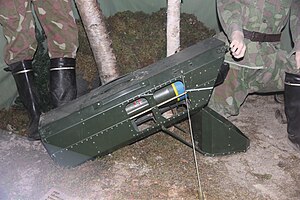Vickers Vigilant
| Vigilant | |
|---|---|
 Vickers Vigilant | |
| Type | Wire-guided Anti-tank missile |
| Place of origin | United Kingdom |
| Service history | |
| In service | 1960s |
| Used by | United Kingdom, Finland, Kuwait, Dubai, Switzerland, United States |
| Wars | none |
| Production history | |
| Designed | 1956 |
| Manufacturer | Vickers-Armstrong (Aircraft) Ltd |
| Specifications | |
| Mass | 31 lb (14 kg) |
| Length | 3.5 ft (1.07 m) |
| Diameter | 0.12 m |
| Warhead | HEAT, 6 kg |
Detonation mechanism | impact |
| Engine | I.C.I. dual-thrust solid fuel rocket |
| Wingspan | 0.27 m |
Operational range | 200 m to 1375 m |
| Flight ceiling | n/a |
| Maximum speed | 348 mph (155.6 m/s) |
Guidance system | MCLOS wire-guided |
Steering system | control surfaces |
Launch platform | infantry or vehicle |
The Vickers Vigilant was a British 1960s era MCLOS wire-guided anti-tank missile used by the British Army. It was also licence-built in the United States by Clevite for the US Marine Corps, and sometimes known as Clevite rounds in this case.[1] It had a short service life, and replacement by the Swingfire began in the mid-1960s.
History[]
Vigilant was a private development begun in 1956 by Vickers-Armstrongs' [2] Guided Weapons Department at Brooklands, Surrey for the anti-tank role in the British Army, the name being formed from VIsually Guided Infantry Light ANti-Tank missile.
Vigilant was wire-guided, optically tracked and manually guided, like the missile it replaced in service, the Malkara. In contrast to that system, however, Vigilant included a more sophisticated guidance system that imparted changes in velocity that produced a much smoother and more predictable motion, whereas the Malkara was considered difficult to accurately guide. The same system was reused in the later Swingfire missile.
As well as infantry use, Vigilant could be mounted on vehicles such as the Ferret armoured car and Land Rovers. Vigilant had a short service life as Swingfire started to replace Vigilant from 1966 onwards.
Description[]
The missile system could be deployed in a number of configurations. The man-portable configuration consists of a launcher which doubles up as a transport container, a combined sight and controller, a battery and a 63 meter long cable. An optional Missile Selector Box allowed up to 6 missiles to be controlled by, and widely separated from, a single sight controller. The launcher box is placed on the ground facing the direction of expected targets, and then connected by the cable to the sight controller, which can be deployed some distance away. The sight controller is a pistol grip design, with two grips. The front grip has the launch trigger, and the rear grip has a thumb joystick for steering the missile. A low-magnification (3.2x) monocular forms the sight itself. Engraved stadia lines allow simple ranging, based on a typical tank target bridging the lines once in range.
The operator tracks the target using the sight mechanism, then launches the missile using the front trigger. Once the missile is in flight, he steers the missile into his line of sight using the thumb joystick. The missile's auto pilot uses a gyroscope to maintain a straight flightpath directly away from the launch point, compensating for any wind buffeting. When the operator moves the joystick, the missile applies a steering correction in the appropriate direction, once the joystick is released the opposite correction is applied automatically, keeping the missile travelling directly away from the launch point. Vigilant has a reputation for ease of control and high success with minimal operator training. This was largely due to the "velocity control" method of Vigilant, relying on gyroscopes, rather than the simpler "acceleration control" of competing missiles such as Entac or SS.11.[3]
The missile[4] reaches its maximum range of 1,375 meters in 12.5 seconds. In testing, the missile's shaped charge warhead penetrated 576 millimeters of armour of 30 to 35 HRC. Two type of warheads were provided for the Vigilant: A British developed warhead with a collapsible probe that extends on launch which can achieve maximum penetration, and one developed by Swiss firm CML with a blunter nose which has a hardened steel ring which, on oblique strikes, will dig into the armor and swing the shape charge warhead around for better penetration.[5][6]
Operators[]

Former operators[]
- Abu Dhabi Defence Forces
- United Arab Emirates Army
 Finland
Finland- Finnish Army
 Kuwait
Kuwait- Kuwait Army
 Libya
Libya Saudi Arabia
Saudi Arabia- Royal Saudi Land Forces
 Switzerland
Switzerland United Kingdom
United Kingdom- British Army
 United States
United States
References[]
Citations[]
- ^ Forbat 2006, p. 262.
- ^ "The Antitank Missile" Flight International, 17 July 1960, p. 823.
- ^ "VIGILANT" FLIGHT International, 27 July 1961, pp. 115-117.
- ^ "Vickers Vigilant" FLIGHT International, 22 May 1959, p. 717, cutaway drawing of Vigilant missiles main components.
- ^ "Around the Stands" FLIGHT International, 13 September 1962, bottom p. 454.
- ^ "BAC Weapons for the Army." FLIGHT International, 29 August 1963, bottom p. 312.
Bibliography[]
- Brassey's Infantry Weapons of the World, J.I.H. Owen
- Forbat, John (2006). The 'Secret' World of Vickers Guided Weapons. Tempus. ISBN 0-7524-3769-0.
External links[]
- "Vigilant Success Story" a 1960 Flight article
- Anti-tank guided missiles of the United Kingdom
- Anti-tank guided missiles of the Cold War
- Military equipment introduced in the 1960s
- Vickers